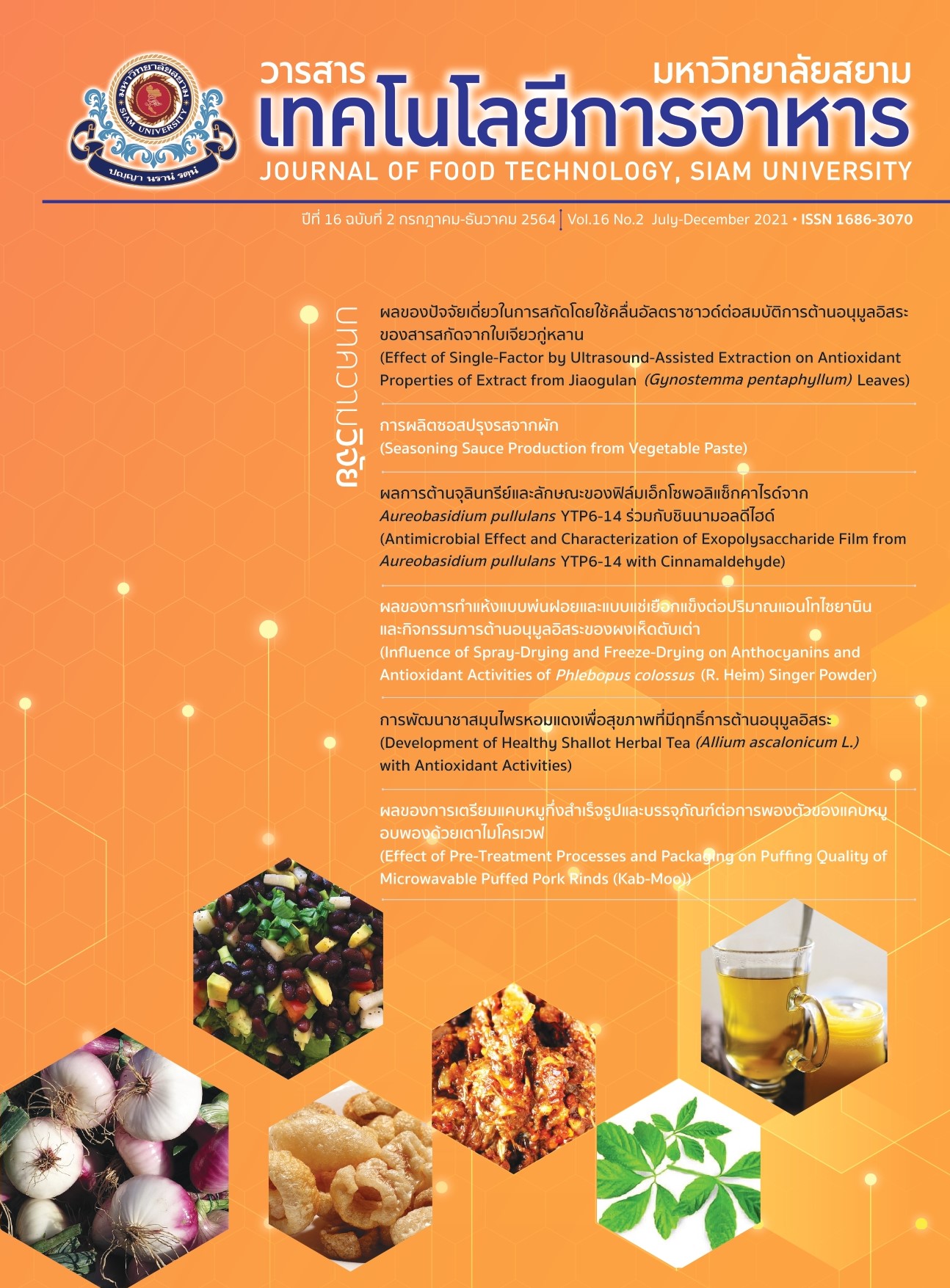Development of Healthy Shallot Herbal Tea (Allium ascalonicum L.) with Antioxidant Activities
Main Article Content
Abstract
This research aimed to develop the healthy herbal tea product from shallots (Allium ascalonicum L.) by creating product concepts from focus group of 20 consumers who like to drink tea (40–65 years old) in Sisaket Province (N=20). It was found that 80% of customers wanted to add value of healthy herbal tea with shallots which was clear, fragrant and a unique local product. The tea formula was developed and optimized by using mixture design, main ingredients of the herbal tea were shallots, while pandan leaves and shallot leaves were tea flavoring agents and response surface methodology (RSM), respectively. Antioxidant activities, physicochemical properties and sensory evaluation of 6 herbal tea formula were compared. The results showed that an increase in shallot leaves and pandan leaves could enhance the brightness (L*), antioxidant activities by using DPPH and ABTS, and sensory scores. The optimal formula ratio of shallots, pandan leaves and shallot leaves analyzed by RSM (R2>0.75) were 45%, 35% and 20%, respectively. The consumer acceptance for shallot herbal tea was tested. The overall liking scores and product acceptance were 7.03 and 98%, respectively. More than 90 % of customers decided to buy this product at a price of THB 100/20 grams.
Article Details
Copyrights of all articles in the Journal of Food Technology available in print or online are owned by Siam University and protected by law.
References
Noramat, P. (2019). Farmers grow organic shallots, large plots, reduce costs, increase income, stable path. [Online] Available from https://www.sentangsedtee.com/ farming-trendy/article_109721. [Accessed January 15, 2021].
Agricultural Research Development Agency (Public Organization). (2016). Shallots. [Online] Available from http://www.arda.or.th/kas- etinfo/north/plant/shallot.html. [Accessed January 15, 2021].
Dejadisai, S. (2010). Herbal articles: shallots. [Online] Available from http://pcog.pharmacy.psu.ac.th/ images/Article/2553/12-53/Shallot.pdf. [Accessed December 5, 2020].
Office of Agricultural Economics. (2020). Agricultural product production data 2020. [Online] Available from http://www.oae.go.th. [Accessed January 15, 2021].
Poolsukkho, P., Waewdee, S., Thongsri, K. and Torsaku, S. (2018). Design and development of prototype machine for peeling shallots for small to medium enterprises. Journal of Engineering, RMTTU. 16(1): 43-50.
Hamer, M. (2007). The beneficial effects of tea on immune function and inflammation: A review of evidence from in vitro, animal, and human research, Nutrition Research. 27(7): 373- 379.
Huang, J., Xie, Z., Wang, Y., Zhang, J. and Wan, X. (2015). Recent advances of anti-hyperglycemia and anti-diabetes actions of tea in animal studies. Current Opinion in Food Science. 2: 78-83.
Martin, M.A., Goya, L. and Ramos, S. (2017) Protective effects of tea, red wine and cocoa in diabetes. Evidences from human studies. Food and Chemical Toxicology. 109(1): 302-314.
Food Intelligence Center Thailand. (2018). Food market share in Thailand. [Online] Available from http://fic.nfi.or.th/FoodMarketShareIn ThailandDetail.php?id=219. [Accessed January 15, 2021].
Wiriyacharee, P. (2018). Sensory evaluation. (2nd ed.). Chiang Mai: Office of Research Administration, Chiang Mai University.
Othong, J., Thongtun, J. and Limsuwan, T. (2016). Development of Yanang (Tiliacora triandra (Colebr.) Diels) herbal tea and its physicochemical properties, antioxidant activity and total phenolic compound. Proceeding of 53rd Kasetsart university, pp1544-1551. February 3-6, 2017, Bangkok. Thailand.
Pongsirikul, I. (2001). Statistical analysis of the results of the program for the agricultural industry. (1st ed.). Chiang Mai: Chiang Mai University.
Srisopa, A. and Wongkrajang, K. (2020). Development of antioxidant and anti-α-glucosidase mulberry leaf tea recipes with combination of aroma herbs. Thai Journal of Science and Technology. 9(2): 218-229.
Tiwari, B.K., O’ Donnell, C.P., Patras, A., Brunton, N. and Cullen, P.J. (2009). Anthocyanins and color degradation in ozonated grape juice. Food and Chemical Toxicology. 47(11):2824–2829.
Maissuthisakul, P., Suttajit, M. and Pongsawatmanit, R. (2007). Assessment of phenolic content and free radical scavenging capacity of some Thai indigenous plants. Journal of Food Chemistry. 100(4): 1409-1418.
Henika, RG. (1982). Use of response surface methodology in sensory evaluation. Journal of Food Technology. 36(11): 96–101.
Jangchud,. A. (2006). Statistics for Product Development and Application. (1st ed.). Bangkok: Department of Product Development, Faculty of Agro Industry, Kasetsart University.
Utama-ang, S., Utama-ang, N. and Pongwiritthon, R. (2015). Consumer acceptance and behavior toward Thai herbal tea products. Srinakharinwirot Research and Development (Journal of Humanities and Social Sciences. 7(3): 187-199.
Assatarakul, K. and Himasuttidach, N. (2017). Antioxidant and antibacterial activities of onion extract and applications in mixed fruit and vegetable juice. Journal of Food Technology, Siam University. 12(1): 71-83.
Ruangrungsi, N. and Tantiwat, P. (1991). Medicinal plants. (1st ed.). Odean Store, Bangkok.


